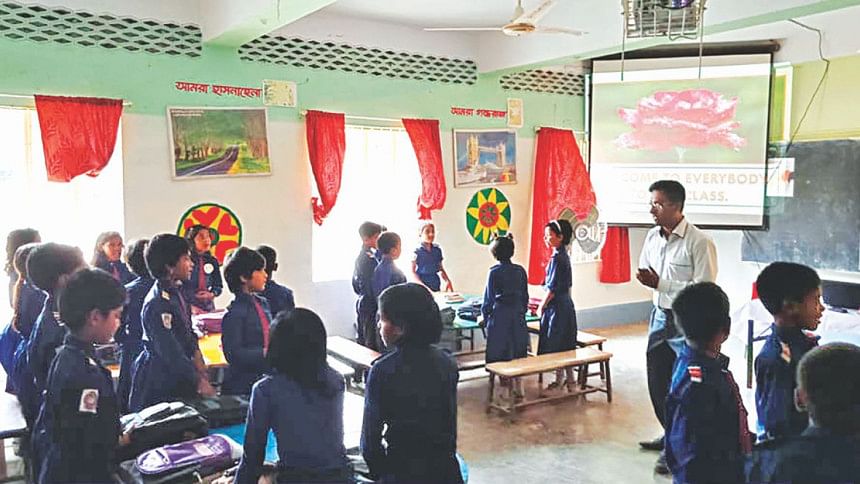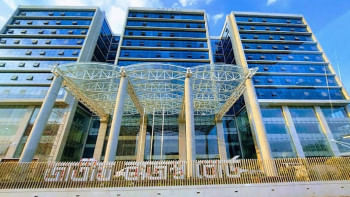A school of change

Modern technology and bright murals make Khagrabari Government Primary School in Pabna's Faridpur upazila exceptional. Multimedia presentations, inspiring paintings of landmarks and historical figures, a computerised attendance system: these are hardly the usual features of a village school. Over the past few years the school's staff and management have gone the extra mile to create a safe and appealing learning environment. They want students to have every possible reason to excel.
“Lessons must be interesting, varied and enjoyable,” says the school's head teacher Abu Based. “Otherwise the education experience is monotonous. We are trying to improve every aspect of the school environment to promote attentiveness.
“Most of the paintings around campus and in the classrooms have been done by our students,” he continues. “We chose motifs like iconic figures and national sites and symbols so they can learn about them.”
“Sometimes children prefer play to more formal activities like reading, especially our youngest students,” says Eti Ara Khatun, a teacher from the infants' section. “We try to accommodate their interests. We have decorated the classroom to bring lessons to life. We rely on cartoons, a doll set, toys and a television to partner their learning.”
Each morning when students arrive, they enter a campus of lively decoration and well-tended grounds, which looks as much like a park or welcoming picnic spot as a school. Students register attendance with electronic identity cards, using a system that automatically generates text messages and sent them to the parents of any absent child. In class, students look forward to interactive multimedia presentations as a routine part of the school day. Meanwhile a ten-camera closed-circuit surveillance system promotes safety.
“Children in our area don't like to miss out on class,” says Monjuara Khatun, the mother of a class-one student. “For them, school is fun.”
“Multimedia lessons make difficult topics easier,” observes Rakibul Hasan, the school's multimedia teacher. “Although we haven't been able to equip all nine classrooms with technology, classroom rotation ensures all students benefit. Students from classes one to eight have access to the thousands of books and geographic models in our digital library.”
The innovative approach is already reaping rewards. Class-four student Jayed Hasan Jisan is typical. Previously weak in English and mathematics, the added visual stimulus of multimedia presentation has led to improved results in both subjects.
Established in 1941, the school of 733 students still copes with an insufficient number of classrooms and teachers. It has a two-storey concrete building with four classrooms, with the remaining classrooms in tin buildings. But Khagrabari is a school determined to make the most of what it has. Remarkably, the institution's technological and methodological transformation has been achieved without additional government funds.
“The chairman of Faridpur upazila council Khalilur Rahman donated the closed-circuit television cameras,” notes Abdul Hamid, president of the school's management committee. “The rest of the technology and other improvements have been paid for through donations from the local community and from our teachers.”
The school also charges each student a monthly fee of Tk 5 for technology maintenance. “The fee isn't too much,” Hamid notes. “We didn't want it to be a burden on parents.”
Unsurprisingly, the school's achievements are appreciated within the education department. “High officials from our directorate, teachers and officers from several districts have already visited this model school,” says Abdus Salam, the district's primary education officer. “They want to see firsthand how a rural school can achieve such a praiseworthy transformation. We want to give whatever assistance we can to help this school continue to advance.”

 For all latest news, follow The Daily Star's Google News channel.
For all latest news, follow The Daily Star's Google News channel. 





Comments